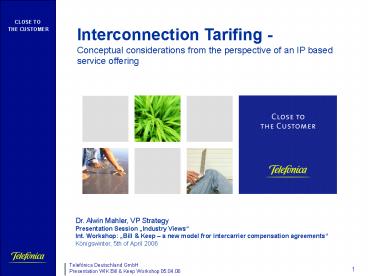PowerPointPrsentation PowerPoint PPT Presentation
1 / 10
Title: PowerPointPrsentation
1
Interconnection Tarifing - Conceptual
considerations from the perspective of an IP
based service offering
Dr. Alwin Mahler, VP Strategy Presentation
Session Industry ViewsInt. Workshop Bill
Keep a new model fror intercarrier compensation
agreements Königswinter, 5th of April 2006
2
Background Characteristics of Internet based
Telephony and Termination/IC Model (I/II)
Content / Voice
SIP-Server of application service provider
Network Provider, demanding termination services
to A
Internet
signaling
CPE of A
- IP based Telephony (application) becomes
independent from the network - The network operator is not necessarily the same
as the application provider - gt QoS can not be guaranteed
3
Background Characteristics of Internet based
Telephony and Termination/IC Model (I/II)
SIP-Server of application service provider
signaling
Network Provider, demanding termination services
to A
IP-Network
phys. Interconnection, dedicated for VoIP
Content / Voice
CPE of A
- but if application service provider and network
operator work together - QoS can be guaranteed via IC agreement securing
quality of signaling/data - Several scenarios arise traffic via dedicated
IC agreement (yes/no), transport included
(yes/no), level of quality - ? The advent of Internet based Telephony is one
of (or) the factor(s) to stipulate the question
for the appropriate model for intercarrier
compensation agreements
4
Possible Tariff Scheme Differentiated Tariffs?
- Introduction of differentiated IC termination
tariffs (in existing CPP/EBC system) - Differentiation corresponding to QoS / underlying
components (for example QoS VoIP equals PSTN IC
fees) - Differentiation QoS yes/no may be unsufficient
more dimensions - ? Problem complexity / implementation (a priori
category determination) - ( also keep in mind costs for differentiated
routing and billing) - Bill Keep
- Simplicity efficiency of system
- Change of system necessary
- Keeping the existing system (without
differentiated tariffs) - Arbitrage-problems
- vs. stability and easy planning
- Systems migrate to similar solutions over time
- Question Which path with which tariff scheme?
5
Introduction of a bill keep regime (I/II)?
- Background
- Bill Keep Interconnection on lowest network
level - different approach for termination tariffs
- Therefore No more termination fees and no need
for regulation - Instead End customers regulate the market by
their demand - Advantages
- Bill Keep could be a way to reduce complexity
- Simple system in principle with positive
incentive effects - Basic assumption rational customers that are
willing to change, they chose the best supplier
and thereby punish other suppliers - Incentive effects on companies are
efficient(suppliers with low costs can offer the
product at market conditions, other suppliers -
who are terminating connections too expensive -
will not be able to pass on these extra costs)
6
Introduction of a bill keep regime (II/II)?
- Prerequisites for efficient bill keep
- Experience many end customers feel bound to a
certain company or they change companies only
after months/years. Regulative effect of end
customers potentially to be complemented by
actions of regulatory authority - ? could lead to shift of (ex ante price)
regulation of termination fees to (ex ante)
end customer price regulation - Potential disadvantages for companies that do not
supply access and connection - ? introduction of a stand-alone bitstream access
necessary - High distortions by uni-directional payments if
bill keep is not implemented universally for
all companies (VoIP, PSTN, mobile) - ? introduction to all areas at the same time
- A way has to be found to insure a frictionless
introduction without possibility of long lasting
discrimination of single business models - Furthermore it has to be decided how a bill
keep scheme will deal with origination tariffs
and interconnection at higher network levels - ? Bill keep potential regime but a change of
system may cause great risks and its
preconditions are difficult to realize
7
Keeping the existing CPP/EBC based regime?
- Background
- proven system with KeL-orientation (KeL costs of
efficient production) - KeL are oriented at efficient production
(Remark only one technology can be efficient at
a certain point of time) - VoIP is the efficient technology
- Considerations
- Possibility of arbitrage by Internet-telephony
- With (currently) lower number of VoIP minutes
unit cost gt PSTN - Possibilities for solutions/reduction of
arbitrage potentials - Pushing a QoS VoIP basis for commercial IC
agreement - End customers decide may lead to differentiated
systems - ( also within intra-carrier-payments, see
commercial basis) - Migration path with a gradual shift towards the
efficient technology - Accepting (decreasing) possibilities for
arbitrage to receive stability - Converging the existing system towards bill
keep by stepwise reduction of IC-tariffs for local
8
Summary Outlook (I/II)
- VoIP QoS depends on collaboration of application
and network provider - Dedicated interconnection via SBC allows QoS
guaranties (gt PSTN) - VoIP can be envisaged in may possibilities/qualiti
es - ? need to be consistently mapped into tariff
schemes and fees - Problem complex tariff schemes may become too
high because of complexity of
VoIP-products - Bill keep is a possible approach if the
following conditions are met - Pot. extension of regulation to end customer
level - Parallel introduction to VoIP, PSTN and mobile
- Existence of a stand-alone bitstream that is
acceptable to market - Consistent fees for origination and
interconnection at higher network levels
9
Summary Outlook (II/II)
- Possible Approach Modification and improvement
of the existing system - If the conditions for BK cannot be met and the
risk of a system change be avoided - Orientation at KeL and efficient technology
- Reduction of arbitrage (potentials) by QoS
differentiation and decreasing IC-fees - Tariffs
- At sufficiently large amounts VoIP is the
efficient technology, with current utilization
PSTN is less costly - Migration path with gradual, symmetric adoption
of IC fees - ? Convergence of systems, based on proven regime?
10
(No Transcript)

